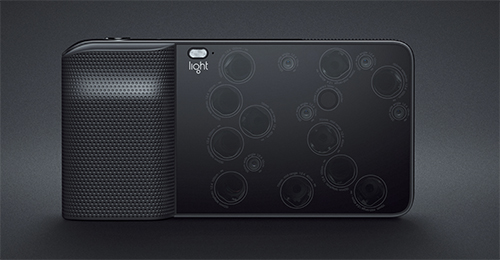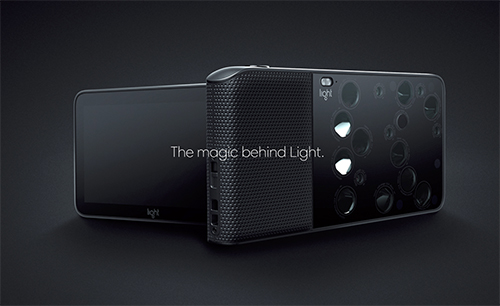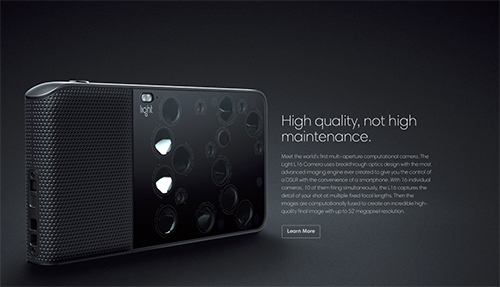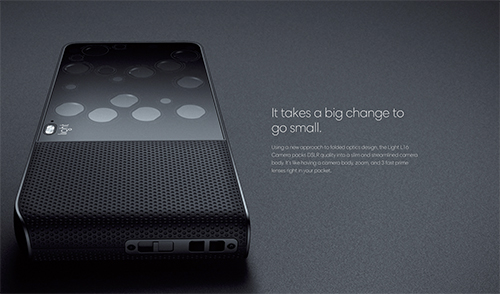Seeing the Light – Rob Van Petten
Last Monday night I was invited to a very enlightening dinner in New York. It was a meeting of the creative board members of Light.co. They have forged the convergence of existing technologies into a revolutionary new camera design.
This is so simple and apparent it made me wonder “Why didn’t I think of this?” Probably for the simple reason that I am not as smart as Rajiv Laroia and Dave Grannan, the founders of Light Co. who have landed upon a brilliant concept. For about 80 years our cameras have been designed around an interchangeable lens system. We buy various lenses depending on their focal length and lens speed because we want different eyes for different situations. We have been bound to our “camera systems” because we invested in an arsenal of lenses. Then every year or so we update our camera bodies because improved sensors and features become available. Lenses retro-fit to the new DSLR bodies, so we lug all this gear around.
But what if all those lens choices, with even better optics, were available inside one camera and were accessed by image software? This is a totally new direction in camera technology. The Light.co L16 has 16 lenses – essentially refined cell phone lenses – in an array configuration using 10 lens at a time, at focal lengths equivalent to 35, 70, and 150mm, that simultaneously shoot a single composite still image. The photographer can simply reset the focal point, focal length, and depth of field in post, using slider software down to F/1.2 in camera… or adjust the dynamic range… and render a 52mp file without cropping or loosing any digital resolution… with great low light capability… or then shoot a 4k video too… and then slide the camera back into your pocket… while grinning that the camera costs less than a single good DSLR lens?
The camera is sleek and streamlined although high tech as hell. The L16 has a wifi download. It shoots 400 images on a single charge and has an optional battery grip that offers a capacity of 800 shots.
The camera face shows the 16 lenses hidden behind a black glass face like the next generation smart phone. An internal software algorithm connects those dots in an altogether new and efficient way for the creative photographer using a 5 inch touch screen control panel. It’s an elegant device, easy to operate and an immensely fluid creative tool. It literally does give you the better quality and control of a DSLR with the convenience of a smart phone.
We all have become accustomed to the smart phone style of shooting as our phones have provided improved image quality and convenience. Light offers super high quality image resolution for large printing and the pursuit of serious photography with the easy access shooting of a mobile device.
So that’s what we were there to see. We played with the camera at dinner shooting some still life images during a quick demo. We watched a presentation about the company and the development of the camera. The fiber optic flow of electrons around the table could be felt among the group. This concept is brilliantly simple and it’s time was inevitable. This is the start of something important. Also the food was so fantastic, we should have shot the meal. Thanks. See the Light https://light.co/camera




Rob, I am flammoxed! I am thinking I just need to go ahead and sell my Nikon Gear, lights and all, and just pick up this camera, and go from there.
I would have laughed at this if it came to me in an email from someone I did not know, but coming from you it has credibility and this sounds like the reinvention of the camera.
Gary
Hi Gary – I’m glad to hear I still have some credibility. This is a revolutionary design. The true test will be how the photo shooting public supports this as a design concept. I think we have already seen the tidal shift in accepting mobile device cameras as the popular mode of picture taking. Now we have a very high quality version of a convenient and current mode camera. The image quality to me is the key. The 52mb RAW, Tif and jpeg options and the image quality I saw was impressive.
The explanation of the lens treatment I got from Rajiv Laroia was that an additional step of refinement has been applied to these lenses which renders them much higher resolution than the standard cell phone treatment for a minimal amount of cost.
When I get an L16 in my hands and test it under real life conditions, I’ll make my evaluation. But from what I saw, I think it’s an ingenious design and for me – It’s all about the image quality.
Nice to hear from you Gary.
Amazing.
Did you check this out?
Yes I did have a chance to check it out and talk to the originators of the company. Quite a novel little camera. There are a number of very ingenious features about this camera that are going to be fun to use. Then big seller for me was the terrific image quality. These are big 52mb files that look great. I’ll be writing more about this very soon. Nice to hear from you Rajnish.